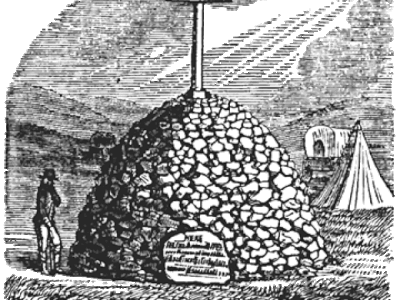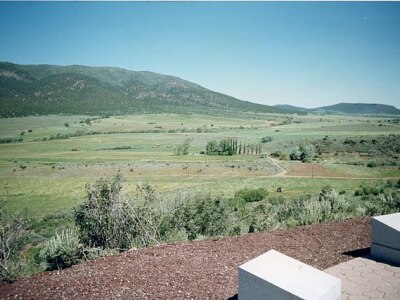The Mountain Meadows Massacre
Central Question
Why did the Mountain Meadows Massacre happen? What caused normally peaceful settlers to commit the crimes that they did?

Image from Hutchings Illustrated, property of the public domain.

Image created by Mark LaMagne, property of the public domain.

Image courtesy of Utah State Historical Society, St. George News.
What Caused the Mountain Meadows Massacre?



The Church of Jesus Christ of Latter-Day Saints, also known as the Mormon church, was organized in the eastern United States in 1830. In 1847, Latter-day Saint pioneers began to settle in the Great Basin in part to get away from disagreements they had with people in the East.
After Utah became part of the United States in 1850, federal officers who weren’t Latter-day Saints were sent to help lead the new territory. These officers sometimes disagreed with the Saints and told government leaders and people in the East that the Saints were causing trouble. Many people in the East also didn’t like that some Latter-day Saint men had more than one wife. Many new Saints who moved to Utah were from Europe, and people in the East didn’t think they would be good, loyal Americans. Some people thought that the Saints were rebelling against the United States.
In 1857 President James Buchanan sent an army of about 2,500 soldiers to stop what some people called the “Mormon Rebellion” in Utah. As the army made the long journey across the Great Plains, Utah prepared for war. The army reminded the Saints of mobs they were trying to get away from when they moved west. Latter-day Saint leaders sent a militia (volunteer army) to the Great Plains to slow down and discourage the U.S. troops. The Latter-day Saint leader, Brigham Young, told the Saints to keep all of their supplies and not sell or trade any. Some church leaders made speeches that told the Saints to prepare to fight and kill and even die for their faith and families.
That same year many emigrants crossed the Great Plains toward California. The Baker, Dunlap, Fancher, Miller and Tackitt families were a part of these emigrant groups. These families each entered the Salt Lake Valley in August then joined together into a large wagon train and followed the “Southern Road” into southern Utah. They happened to arrive in Utah just as the Saints were preparing for war with the U.S. Army. The emigrants got into disagreements with the Saints over grasslands and supplies as they passed through several cities. The worst disagreements happened in Cedar City on September 3, 1857.
There were also many Indian nations in Utah during the time. The Latter-day Saints wanted the Indians to help them fight against the U.S. soldiers. When emigrants saw the Saints being friendly with the Indians it made them nervous. Even so, the Indians sometimes felt like the Saints were not treating them the right way. As part of the war, Latter-day Saint leaders asked the Indians to try to chase the cattle away from emigrant groups and the army.
On September 11, 1857, the emigrant train was massacred by Latter-day Saints and Paiute Indians at a place called Mountain Meadows. About 120 people, including many women and children, were killed. A few young children were allowed to live. After the massacre those who did it took the emigrants’ belongings and tried to hide what they had done.
Without knowing what had happened to the emigrants, the U.S. army got stuck near Fort Bridger, in what is now Wyoming, during the winter. This gave the Latter-day Saint leaders and U.S. leaders a chance to meet and to find a solution to their disagreements. Their meetings ended what some people call the “Utah War” before any real fighting happened between the Mormon militia and the U.S. army.
Many years after the massacre, the government accused John D. Lee of leading the Mormon militia and the Indians who had killed the emigrants. He was convicted and executed 20 years after the massacre at the site where it had happened. The Latter-day church punished some of the Saints who were involved. Eight Latter-day Saint leaders and militia leaders hid from law enforcers for the rest of their lives. Some Paiutes were looked down on by both Indians and others for killing the emigrants.
Archive
Sallie Baker Mitchell
Massacre at Mountain Meadows
Blood of the Prophets
Military Special Report
John D. Lee
Brigham Young
George A. Smith
P. M. Warn
George Powers
Dimick B. Huntington
Elias Morris
Clifford Jake
Interpretations of the Event
This lesson can be adapted to fulfill either a Utah History Core Standard or a US History I Core Standard. Find the resources for both classes below.
7th Grade:
UT Standard 2.4: Students will research multiple perspectives to explain one or more of the political, social, cultural, religious conflicts of this period, including the U.S. Civil War and more localized conflicts such as the Utah War, the Mountain Meadows Massacre, the Bear River Massacre, the Black Hawk War, or other Federal-Mormon conflicts.
8th Grade:
U.S. I Standard 6.2: Students will use primary sources representing multiple perspectives to interpret conflicts that arose during American expansion, especially as American Indians were forced from their traditional lands and as tensions grew over free and slave holding territory.
Lesson Plan: Utah History Standard 2.4
Teacher Debriefing Materials
Student Graphic Organizer for Primary Source Activity
Lesson Slides for Background Information
Lesson Vocabulary List
Instructions for Graphic Organizer
Teachers: You may need to simplify, adjust, or scaffold these instructions for students, depending on grade level/ability. This is just a general outline.
Analyze all 11 sources from the archive page. (Teachers: you can add or remove rows from the table if you want students to look at fewer sources)
In the first column, write the name of the source, the audience, and the purpose behind the source being written.
The next four columns are a place to list strengths and weaknesses of each source, and how they support or impair each interpretation. In each row, follow the prompt to fill in the relevant analysis.
Work with your group members and discuss why each section is filled out as it is. Pay attention to which theory is being supported by a majority of primary source material.
Go back to your assigned seat and discuss the last question with your elbow partner, and then answer it individually on your worksheet.